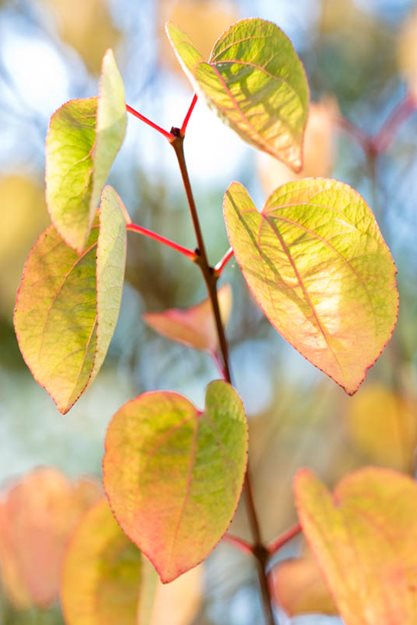Expert Plant Picks for Your Fall Garden
Dan Hinkley’s alluring plant selections for the fall garden offer up thrilling displays of purples, pinks, and reds as other plants and seed heads are turning brownOf all the seasons, autumn has always been my favorite. It is a time of gathering. Squashes and pumpkins are stacked in our larder, bundles of garlic and onions hang to dry, and, in our maritime climate, expanses of green tomatoes await the ripening process atop yesterday’s news stories. Before their journeys south, birds fatten from seeds and fruits offered from a landscape in decrescendo.
The coloring of autumn leaves has always seemed a fascinating truncated replay of the prior months of sun or lack thereof. More rays and warmth equals more ample sugars, flavonoids, and carotenoids in foliage. And as the masking green chloroplasts disintegrate, these other pigments are revealed. Some plants are more consistent in this reward than others.

Cercidiphyllum japonicum 'Heronswood Globe' (katsura tree). Photo by: Richard Bloom.
For moderate to large gardens in evenly moist soils, Cercidiphyllum japonicum (katsura tree), slays any competition in regard to autumn effect. Its oval foliage of green-suffused rose throughout the summer transmutes to coral and yellow-orange in mid-autumn—earlier if the year is particularly dry. It is not color alone that is brought forth by its annual turn of foliage, but a tantalizing scent some describe as cinnamon, others as cotton candy. I suggest the more caloric crème caramel. A globular, more compact cultivar, ‘Heronswood Globe’, is a good choice for the smaller garden.
Unparalleled for its offering of ornament throughout the year, Clethra barbinervis (Japanese summersweet)remains, in my opinion, one of the most satisfying shrubby deciduous trees that can be grown. Adaptive to most of North America, its mottled bark in winter rivals that of the finest Stewartia. Dark green, boldly textured foliage in summer is a good foil for its racemes of highly spiced white flowers in July and August. In autumn, even in shade, the leaves turn to glowing tints of orange-red before falling.
Though lacking the effects of mottled bark, Lindera obtusiloba and Lindera triloba (spicebush)—both from eastern Asia—offer distinctive textural qualities and impressive autumn dress. The former, with three-lobed leaves similar to the American sassafras, and a late-winter haze of yellow flowers akin to Cornus mas (cornelian cherry), this 15-foot small tree becomes radiant in tones of clear yellow in October. The latter, Lindera triloba, is smaller in all regards, also with three-fingered leaves but coloring in autumn to tones of tangerine and melon.

Vitis vinifera ‘Purpurea’ (purpleleaf grape). Photo by: Marianne Majerus.
Hardy deciduous vines with excellent autumn notes are far from common, outside of the inarguably brilliant fall performance of Toxicodendron radicans (poison ivy). Several cultivars of Vitis (grape), grown on a small arbor or fence do double duty, providing fruit for the table or glass and a visual feast of claret purple long into autumn. Vitis vinifera ‘Purpurea’ is especially good, possessing a purple cast throughout summer and sensational autumn tints of scarlet, though its fruit is notoriously unpalatable.

Vitis coignetiae (crimson glory vine). Photo by: Richard Bloom.
Vitis coignetiae, from the mountains of Japan, represents another grape grown for its ornament rather than fruit. Its broad, glossy-green foliage transmutes to dazzling shades of orange, scarlet, and yellow in autumn. It is a vigorous vine that must be given an adequately sized tree or trellis on which to climb.

Viburnum setigerum 'Aurantiacum' (tea viburnum). Photo by: Rob Cardillo.

Callicarpa bodinieri var. giraldii ‘Profusion’ (beautyberry) can’t help but draw attention with clusters of glossy purple ornamental berries on 6-foot stems. Photo by: Rob Cardillo.
The effects of autumn on fruit are equally dazzling. Viburnum setigerum 'Aurantiacum' (tea viburnum) consistently produces enormous crops of bright orange-red berries that remain effective until they’re consumed by birds in early winter. It’s beautiful in combination with Callicarpa bodinieri var. giraldii ‘Profusion’ (beautyberry) with plentitudes of beguiling purple fruit clustered along stems to 6 feet in height. It’s a color infrequently offered to temperate gardeners by way of fruit or flower. If adequate room exists in the garden, consider a pair of Idesia polycarpa (Igiri tree). This fast-growing tree possesses bold, heart-shape leaves that ripen to a handsome yellow, while, on female specimens, startlingly large pendent clusters of orange berries persist through much of winter. Both male and female trees must be present to set fruit.

Osmanthus heterophyllus (false holly). Photo by: Richard Bloom.

Elaeagnus pungens ‘Maculata’ (variegated silverthorn). Photo by: Marianne Majerus.
Autumn is not just about the end of the cycle. Many plants are just beginning to awaken and ready themselves for the procreative process. Osmanthus heterophyllus (false holly) presents sweetly scented white flowers in September, nestled amongst its dark evergreen foliage. Elaeagnus pungens ‘Maculata’ (variegated silverthorn), is another autumn blossoming, evergreen shrub that I would not be without in my garden. Quick to establish, in October powerfully fragrant white flowers are produced, each coated with an overlay of silver scales.

Cyclamen hederifolium (ivy-leaved cyclamen). Photo by: Richard Bloom.
It was not until I arrived in western Washington that I made my acquaintance with Cyclamen hederifolium (ivy-leaved cyclamen), with delicate, reflexed pink or white flowers arising from the ground when the days shorten and the first autumn rains arrive. Later, its handsome silver-mottled leaves appear and will carry the garden throughout the winter. It is one of the finest gifts to the autumn landscape and one of many that will invite the gardener into a season of hidden charms. Read more about how to grow cyclamen.

